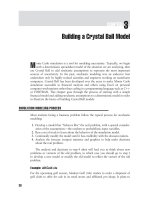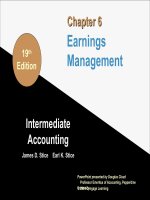Managerial decision modeling with spreadsheets by stair render chapter 06
Bạn đang xem bản rút gọn của tài liệu. Xem và tải ngay bản đầy đủ của tài liệu tại đây (351.02 KB, 45 trang )
Chapter 6
Integer, Goal, and Nonlinear
Programming Models
© 2007 Pearson Education
Variations of Basic
Linear Programming
• Integer Programming
• Goal Programming
• Nonlinear Programming
Integer Programming (IP)
Where some or all decision variables are
required to be whole numbers.
• General Integer Variables (0,1,2,3,etc.)
Values that count how many
• Binary Integer Variables (0 or 1)
Usually represent a Yes/No decision
General Integer Example:
Harrison Electric Co.
Produce 2 products (lamps and ceiling fans)
using 2 limited resources
Decision: How many of each product to
make? (must be integers)
Objective: Maximize profit
Decision Variables
L = number of lamps to make
F = number of ceiling fans to make
Lamps
Fans
(per lamp)
(per fan)
Profit
Contribution
$600
$700
Hours
Available
Wiring Hours
2 hrs
3 hrs
12
Assembly Hours
6 hrs
5 hr
30
LP Model Summary
Max 600 L + 700 F
($ of profit)
Subject to the constraints:
2L + 3F < 12
(wiring hours)
6L + 5F < 30
(assembly hours)
L, F > 0
Graphical Solution
Properties of Integer Solutions
• Rounding off the LP solution might not
yield the optimal IP solution
• The IP objective function value is usually
worse than the LP value
• IP solutions are usually not at corner
points
Using Solver for IP
• IP models are formulated in Excel in the
same way as LP models
• The additional integer restriction is entered
like an additional constraint
int - Means general integer variables
bin - Means binary variables
Go to file 6-1.xls
Binary Integer Example:
Portfolio Selection
Choosing stocks to include in portfolio
Decision: Which of 7 stocks to include?
Objective: Maximize expected annual
return (in $1000’s)
Stock Data
Decision Variables
Use the first letter of each stock’s name
Example for Trans-Texas Oil:
T = 1 if Trans-Texas Oil is included
T = 0 if not included
Restrictions
•
•
•
•
•
Invest up to $3 million
Include at least 2 Texas companies
Include no more than 1 foreign company
Include exactly 1 California company
If British Petro is included, then
Trans-Texas Oil must also be included
Objective Function (in $1000’s return)
Max 50T + 80B + 90D + 120H + 110L +
40S + 75C
Subject to the constraints:
Invest up to $3 Million
480T + 540B + 680D + 1000H
+ 700L + 510S + 900C < 3000
Include At Least 2 Texas Companies
T+H+L > 2
Include No More Than 1 Foreign Company
B+D < 1
Include Exactly 1 California Company
S+C = 1
If British Petro is included (B=1), then
Trans-Texas Oil must also be included (T=1)
Combinations
of B and T
B=0
T=0
T=1
ok
ok
B=1 not ok
ok
B
prevents the unacceptable one
Go to file 6-3.xls
Mixed Integer Models:
Fixed Charge Problem
• Involves both fixed and variable costs
• Use a binary variable to determine if a
fixed cost is incurred or not
• Either linear or general integer variables
deal with variable cost
Fixed Charge Example:
Hardgrave Machine Co.
Has 3 plants and 4 warehouses and is
considering 2 locations for a 4th plant
Decisions:
• Which location to choose for 4th plant?
• How much to ship from each plant to each
warehouse?
Objective: Minimize total production and
shipping cost
Supply and Demand Data
Warehouse
Detroit
Monthly
Demand
Plant
Production
Monthly
Cost
Supply
(per unit)
10,000
Cincinnati
15,000
$48
Houston
12,000
Kansas
City
6,000
$50
New York
15,000
Pittsburgh
14,000
$52
Los Angeles
9,000
Total
46,000
35,000
Note: New plant must supply 11,000 units per month
Possible Locations for New Plant
Production Cost
(per unit)
Fixed Cost
(per month)
Seattle
$53
$400,000
Birmingham
$49
$325,000
Shipping Cost Data
Decision Variables
Binary Variables
Ys = 1 if Seattle is chosen
= 0 if not
YB = 1 if Birmingham is chosen
= 0 if not
Regular Variables
Xij = number of units shipped from plant i
to warehouse j
Objective Function (in $ of cost)
Min 73XCD + 103XCH + 88XCN + 108XCL +
85XKD + 80XKH + 100XKN + 90XKL +
88XPD + 97XPH + 78XPN + 118XPL +
113XSD + 91XSH + 118XSN + 80XSL +
84XBD + 79XBH + 90XBN + 99XBL +
400,000YS + 325,000YB
Subject to the constraints:
(see next slide)
Supply Constraints
-(XCD + XCH + XCN + XCL) = -15,000 (Cincinnati)
-(XKD + XKH + XKN + XKL) = - 6,000 (Kansas City)
-(XPD + XPH + XPN + XPL) = -15,000 (Pittsburgh)
Possible Locations for New Plant
-(XSD + XSH + XSN + XSL) = -11,000YS (Seattle)
-(XBD + XBH + XBN + XBL) = -11,000YB (B’ham)
Demand Constraints
XCD + XKD + XPD +XSD + XBD = 10,000
XCH + XKH + XPH +XSH + XBH = 12,000
XCN + XKN + XPN +XSN + XBN = 15,000
XCL + XKL + XPL +XSL + XBL = 9,000
(Detroit)
(Houston)
(New York)
(L. A.)
Choose 1 New Plant Location
YS + YB =1
Go to File 6-5.xls









